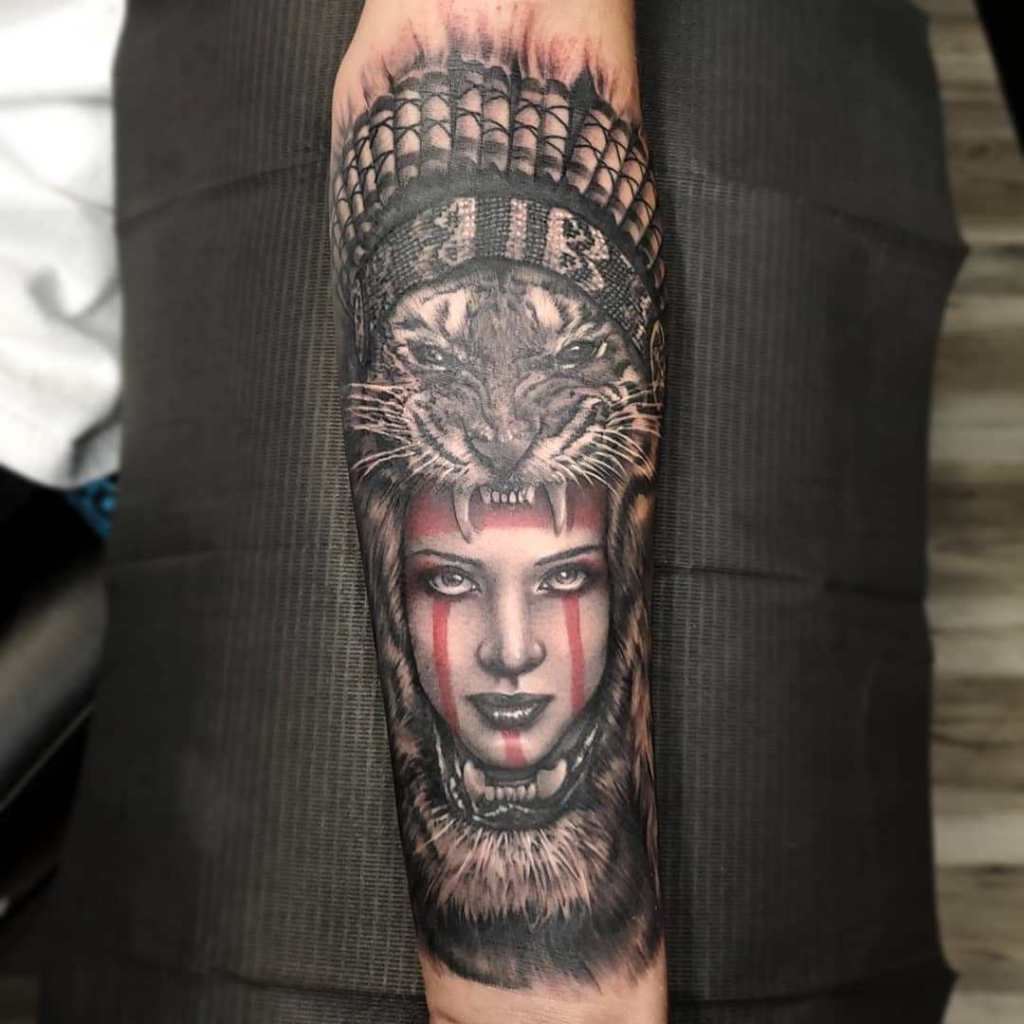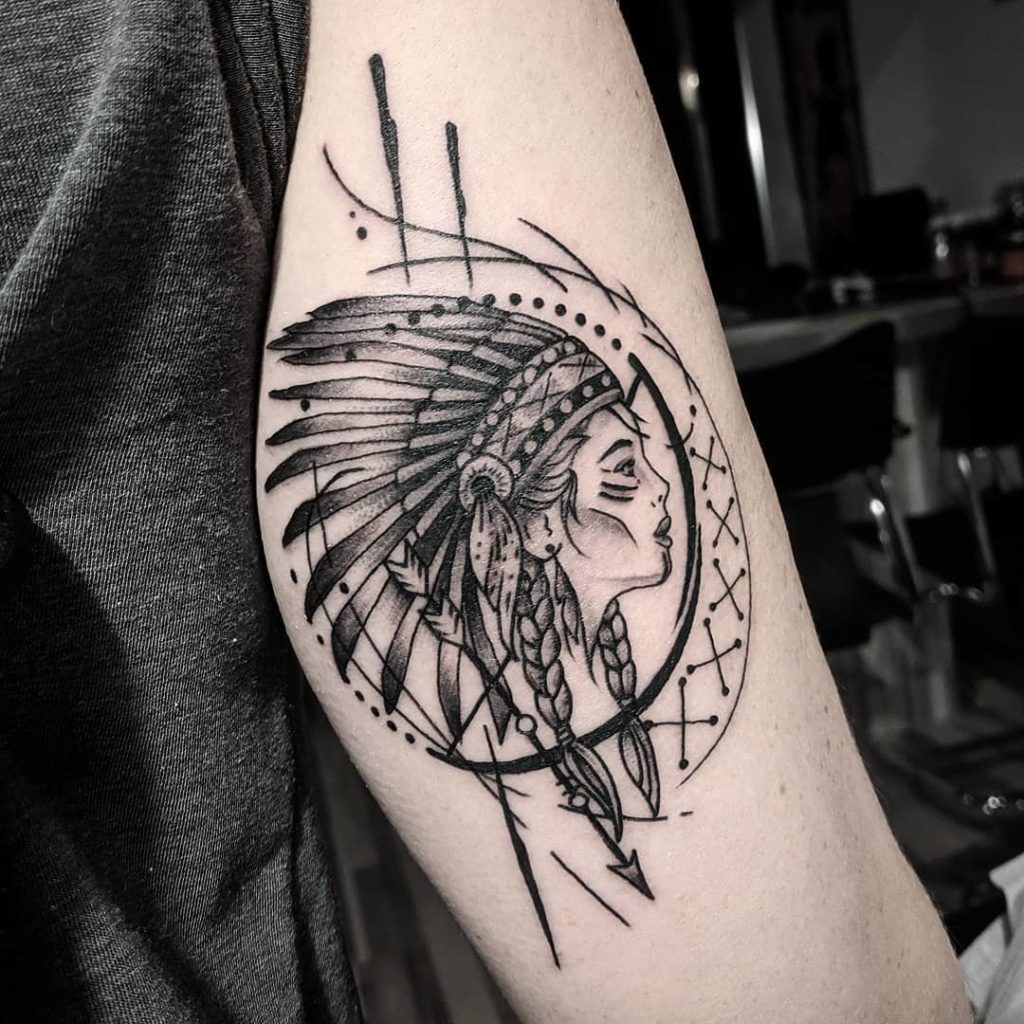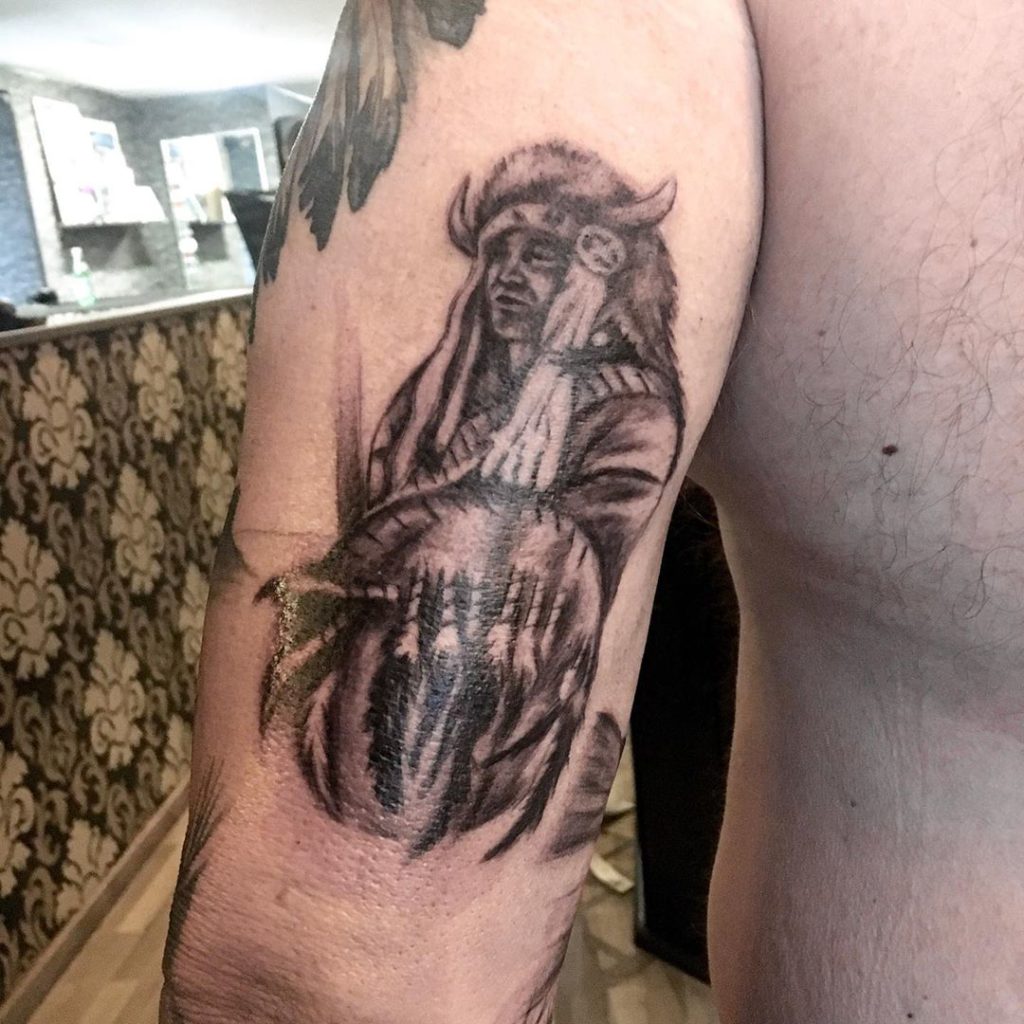Table of Contents
Welcome to an intriguing exploration of an ancient art form – Native American tattoos. This rich tradition, imbued with symbolic significance and spiritual depth, has been a vital part of Native American culture for centuries. This blog post will delve into the rich history, profound symbolism, and diverse styles of Native American tattoos.
Each inked mark carries a story, a purpose, and a link to an ancestral world view that continues to be vibrant today. You’ll learn how these tattoos were not just ornamental but reflected an individual’s social status, spiritual beliefs, and personal achievements. They served as protective amulets, rites of passage, and expressions of personal identity.
We’ll unravel the meanings behind the most popular motifs – from the mighty eagle representing strength and freedom to the humble turtle symbolizing wisdom and longevity. You’ll get a glimpse into the various tribal styles, understanding the distinct differences between the intricate geometric patterns of the Hopi tribe and the bold, animal-inspired designs of the Sioux.
Moreover, we’ll also shed light on the traditional methods used for tattooing and how modern Native American tattoo artists are working to preserve their ancestral practices while innovatively interpreting them for the 21st century.
Prepare to embark on a journey that marries past with present, art with identity, and skin with spirit. By the end of this post, not only will you gain a deeper appreciation for Native American tattoos but also a broader understanding of the cultures they spring from. Be ready for a rich immersion in tradition, symbolism, and artistry that is as captivating as the tattoos themselves.
Native Indian Tattoo

Despite common misconceptions, Native American tattoos depicting female portraits are not exclusively designed for women. These captivating tattoos often illustrate women due to their pivotal roles as mothers, warriors, builders, and spiritual leaders within Native American societies. Known as Native American maiden tattoos, these designs harmoniously blend tradition with aesthetics, serving as perfect choices for sleeve tattoos or cover-ups. These tattoos stand as a testament to feminine strength and resilience.
Native American Woman Tattoo

The Native American Warrior Woman Tattoo makes for a bold, striking piece. Incorporating various elements of Native American culture, such as eagle feathers and warrior symbolism, this tattoo is largely inked in black with color accents. This design pays homage to the enduring spirit of Native Americans and is an ideal choice for those wishing to embody their inner strength.
Traditional Thunderbird American Tattoo

A symbol of power and spirit, the Thunderbird holds an esteemed place in Native American lore. The Thunderbird offers a plethora of tattoo design options, ranging from geometric shapes to vivid colors or stark black and white. Symbolizing inner strength and spiritual connection, this tattoo serves as a compelling testament to Native American mythology and heritage.
Native American Skull Tattoo

Drawing inspiration from the tradition of preserving animal skulls, Native American Skull Tattoos exude an air of mystery. These tattoos, also known as Indian tattoos, represent life’s transience and the cycle of birth and death. These unisex designs, suitable for both full and half sleeves, possess a uniquely eerie yet intriguing appeal.
Native American Headdress Tattoo

Express your creative side with the vibrant and detailed Native American Headdress Tattoo. This design, often known as the Native American Girl Tattoo, presents a warrior woman embellished with a traditional headdress. These tattoos capture the strength, grace, and beauty of Native American women and their culture.
Stunning Dreamcatcher Tattoo

Dreamcatchers, revered symbols of protection in Native American culture, serve to filter out negative dreams and allow positive ones to pass through. The circular design represents life’s cycle, making the Dreamcatcher tattoo a perfect blend of beauty, symbolism, and heritage.
Wolf Native American Tattoo

The Wolf Native American tattoo, with its elements of Native American culture like the majestic wolf, vibrant feathers, and a headdress, forms a potent emblem of courage, strength, and loyalty. This design serves as a powerful piece of body art, perfectly suitable for a chest placement.
Beautiful Indian Girl Tattoo

Add an element of monochrome beauty to your tattoo collection with the All-Black Indian Girl Tattoo. This design converges key elements of Native American culture into a striking all-black ink piece. This tattoo could be your ideal choice for embracing the strength and beauty of Native American culture.
Creative Native American Tattoo Designs

For those seasoned in the tattoo world, an intricate Native American tattoo that celebrates the beauty, pride, and resilience of Native American women can make a grand addition. This detailed design is ideal for those who are comfortable with the needle’s hum, transforming the skin into a canvas of art.
Simple Native American Tattoo Designs

Feathers, symbolic of strength, wisdom, freedom, loyalty, and power in Native American culture, make for simplistic yet meaningful tattoos. Feather tattoos are minimalistic designs that can be small and simple, making them ideal for first-time tattoo enthusiasts or those who prefer subtle body art.
Watch A Video Of The Best 100+ Native American Tattoos You Need To See!
.
Cherokee Native American Culture Tattoo

Cherokee tattoos are considered family crest tattoos, representing a rich familial history. These designs are not simply generic tattoo designs but are steeped in cultural significance, often integrating various elements from Cherokee tradition. Remember, the most meaningful tattoos are personal, and a Cherokee tattoo is a powerful badge of identity, respect for one’s roots, and an acknowledgment of ancestral lineage.
Need More Inspiration






















































































What Are The Traditional Methods Used For Native American Tattooing?
Native American tribes have been using tattoos as a form of self-expression, spiritual practice, and social status for thousands of years. However, their methods of tattooing varied widely and depended heavily on available resources, regional practices, and the tribe’s specific culture.
One of the most common traditional methods involved using a sharp needle or bone fragment to pierce the skin. The needle would be repeatedly dipped in a natural dye or ink, which was often made from soot or crushed minerals, and then pricked into the skin to create the desired pattern. This is a technique often referred to as “stick and poke” or “hand-poked” in today’s tattoo terminology.
Another technique used by some tribes involved cutting the skin with a sharp object, then rubbing the dye into the wound to create the tattoo. This method, known as scarification, results in raised scars and was often used for both aesthetic and ritualistic purposes.
Some tribes also employed a method known as “tapping” or “hand-tapped.” In this method, a needle or sharp bone was attached to a stick, which was then tapped with another stick, driving the needle into the skin. The needle would be repeatedly dipped in ink and tapped into the skin to create the design.
It’s important to note that these traditional methods could be quite painful and riskier than modern techniques due to less sanitary conditions and a higher likelihood of infection. Today, many tattoo artists who draw on Native American heritage and styles use modern electric tattoo machines while still respecting and paying homage to their cultural roots. However, there’s a growing movement among indigenous tattoo artists to revive these traditional methods, albeit with modern hygiene standards.
Are There Any Specific Tribes That Have Their Distinct Style Of Tattooing?
Yes, different Native American tribes had their unique styles and symbolisms for tattoos. These were often reflective of their culture, spiritual beliefs, and regional fauna and flora. A few examples include:
- Haida Tribe: Located in the Northwest Coast, the Haida tribe is renowned for their complex and highly stylized tattoo designs. These often depicted local fauna like eagles, ravens, bears, and orcas, depicted in a unique form-line style. Haida tattoos were traditionally meant to display the individual’s lineage, social status, and specific personal achievements.
- Iroquois Tribe: The Iroquois people, also known as the Haudenosaunee, traditionally used tattoos as a form of medicinal therapy in addition to their aesthetic and ceremonial purposes. Their designs were often quite abstract and complex, with each marking holding a specific meaning related to the individual’s personal experiences or tribal traditions.
- Inuit Tribe: Inuit tattoos, known as kakiniit, were traditionally created by puncturing the skin with a needle and thread soaked in soot or seal oil. This resulted in a stitched appearance. These tattoos often consisted of symmetrical designs on the face, hands, and forearms, serving both spiritual and societal functions.
- Cherokee Tribe: Cherokee tattoos often carried profound spiritual significance, symbolizing one’s relationship with specific animals, spirits, or natural elements. Designs often included animals such as bears, deer, and wolves, as well as celestial bodies like the sun and moon.
- Plains Tribes: Tribes from the Great Plains, like the Lakota and Sioux, often used tattooing to denote warrior status and accomplishments in battle. Symbols frequently incorporated included the eagle, buffalo, horse, and various war symbols.
Please note that due to the rich diversity and broad range of Native American cultures, there are many more tribes each with their unique tattooing traditions and symbolisms. It’s also worth noting that the meanings of many traditional Native American tattoos have been lost or distorted over time due to historical disruption and cultural assimilation. Therefore, the respectful use of these traditional symbols requires careful research and understanding of their cultural significance and history.
Are Modern Native American Tattoo Artists Able To Preserve Their Ancestral Practices While Innovatively Interpreting Them For The 21st Century?
Absolutely. There is a growing movement among modern Native American tattoo artists to not only preserve the ancestral tattooing practices of their tribes but also innovate these traditions for the 21st century. These artists are striking a delicate balance, infusing traditional tattoo art with modern elements, all while maintaining the integrity and cultural significance of their ancestral practices.
Artists often work by studying their tribe’s traditional designs and symbolisms, then adapt and reinterpret these elements in a way that is relevant and relatable to contemporary society. They utilize modern tattooing techniques and tools, ensuring high standards of safety and precision, while their designs incorporate traditional motifs and symbolisms. For instance, they might use an electric tattoo machine to ink a design inspired by traditional Haida form-line art or the intricate geometric patterns of the Plains tribes.
Moreover, many artists actively promote education and cultural awareness through their work. They engage with clients to ensure they understand the cultural significance and history behind the designs they choose, encouraging respectful and meaningful engagement with Native American cultures.
However, it’s important to note that while there is a push towards modernizing and popularizing traditional Native American tattoo art, there is also a firm emphasis on preserving the sacred and spiritual aspects of these practices. Some symbols and rituals remain strictly within the tribes and are not used in mainstream tattooing, out of respect for their sacred nature. This balanced approach to modernizing and preserving traditional tattooing practices helps to keep these cultural art forms alive and relevant in the modern age while honoring their roots and significance.
Conclusion
In conclusion, Native American tattoos offer a wealth of symbolism and cultural significance that can provide depth and personal resonance to your choice of body art. Whether you’re drawn to the powerful imagery of the Warrior Woman, the spiritual guidance of the Thunderbird, or the minimalist elegance of the feather, these designs offer a myriad of options to match your personal style and values.
Remember, however, that getting a tattoo is not a decision to be taken lightly. Proper research about the design’s cultural connotations, careful selection of a professional tattoo artist, and strict adherence to aftercare instructions are critical steps to ensure a positive tattoo experience. Moreover, it is crucial to approach these culturally significant designs with respect and understanding, acknowledging their origins and significance.
Lastly, the use of Native American designs in tattoos carries with it an inherent responsibility to honor and respect the culture they represent. It is always advisable to understand the context and meaning of the chosen design fully, as misappropriation or misuse of cultural symbols can lead to unintended offense.
Tattoos are a profound form of self-expression, transforming your body into a canvas of your personal journey, values, and beliefs. By choosing a Native American tattoo, you carry with you a piece of an ancient, vibrant culture, preserving its spirit in a contemporary world. This blog post has hopefully equipped you with the knowledge and motivation to make an informed decision about your tattoo journey, taking you a step closer to wearing your story on your skin.
Feature image from Pinterest



